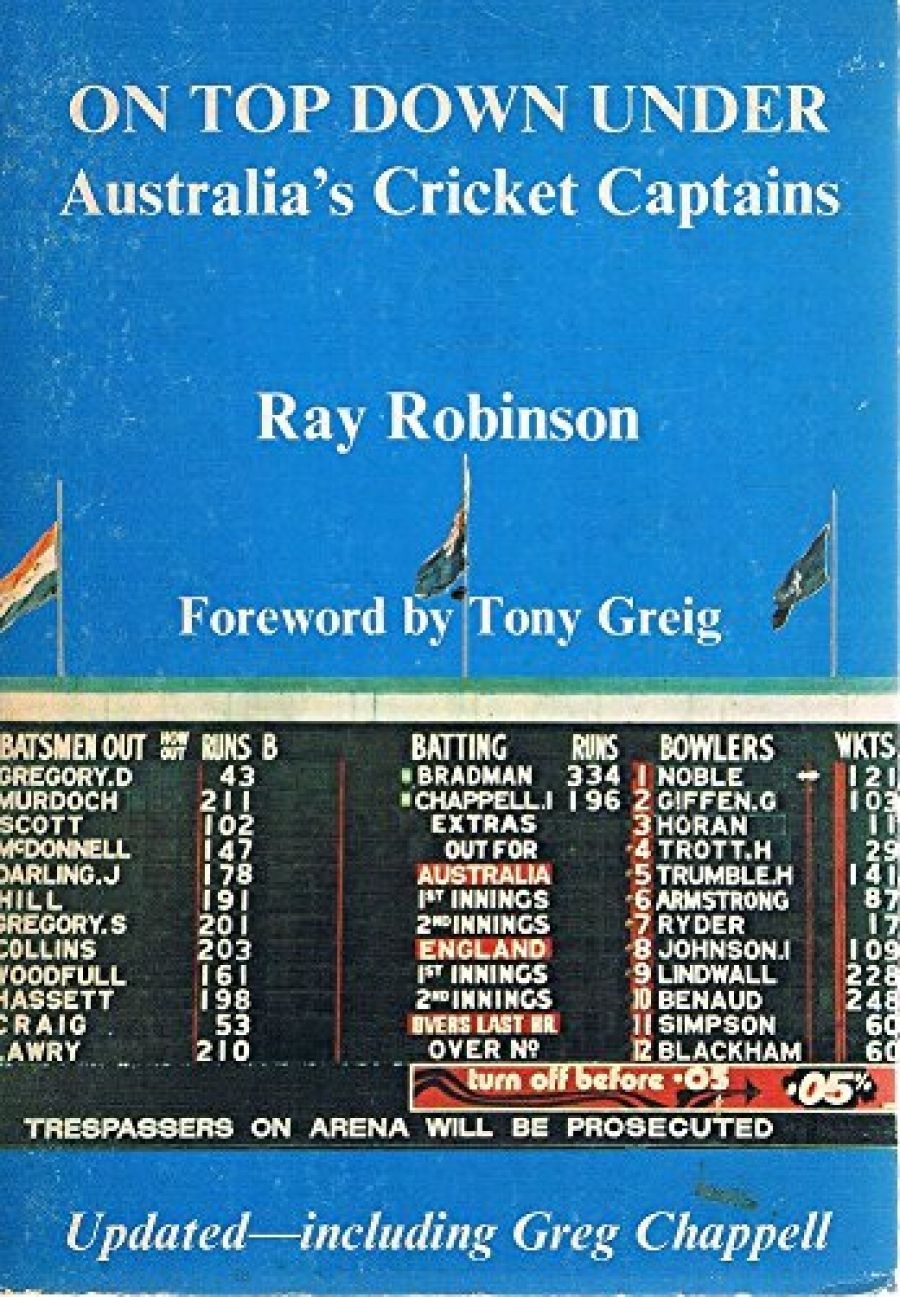
- Free Article: No
- Contents Category: Sport
- Review Article: Yes
- Online Only: No
- Custom Highlight Text:
Cricket is a remarkably fickle game. As Greg Chappell went about season 1981–82 collecting ducks as successfully as any Balinese farmer, Ray Robinson might well have rued his final line on one of Australia’s most-ever favoured batsmen: ‘At thirty-two he had achieved the kind of fame that needs no Academy Award of a foot-high golden statuette.’
- Book 1 Title: On Top Down Under
- Book 1 Biblio: Cassell, 285 pp, $9.95 pb
In Harry Trott, for example, we see the highs and. lows of a sporting life. Early success presaged his considerable all-round skills. And, says Robinson, his elevation to the Australian captaincy disregarded his inferior social status of Collingwood-born postman. He was a born captain in the Australian mould: perceptive, flexible, and unorthodox. By Chappell’s non-Oscar age of thirty-two, though, Trott had ballooned to 102 kg and lost sight in one eye. A serious illness produced mental depression, but he fought it to successfully re-enter state cricket. After all that, he had to suffer his equally talented brother’s suicide, before surrendering to his own affliction.
Robinson’s book is full of such evocative material and confirms cricket as a principal Australian social institution whose stars rank above those of most other fields. So it is galling to report that there are far too many typographical errors to serve any writer, let alone one of Robinson’s stature.
Amidst the riches, though, room remains for more wealth. Between first and second editions, for example, cricket underwent perhaps its greatest upheaval, brought on by the incursion of full commercialism. Somehow here, the full implications of that incursion remain uncaptured. Mention of it, quite properly, comes with the brothers Chappell, Graham Yallop, Bobby Simpson, and Kim Hughes. But business seems almost as usual in this coverage when very clearly it was not. Greg Chappell’s career, for one, has been transformed (some might say transfixed) by the Packer revolution. It might not have been a Freudian slip which prompted Robinson to say the younger Chappell needed no gold statuette to affirm his place. On the other hand, Hollywood and cricket have come noticeably closer together of late – The Cricketer of the Year Award is as much for entertainment as any Oscar.
To be fair, Robinson did not set out to write up that cricket tumult. But its impact contains considerable ramifications for his subjects, and the lack of coverage sometimes alters their images.
Take Kim Hughes. He remains one of Australia’s most complex and enigmatic players ever, let alone captains. His impetuosity and unpredictability are legendary. And his career has indubitably been moulded by the events of 1977. Robinson is eminently fair to Hughes whose batting skills he captures nicely. But no stretch of mind can accord Hughes the same captaincy perceptions as, say, Harry Trott. For Hughes is a classic model of the late maturer. His skills as a juvenile batsman were in the realms frequented by Bradman and Chappell G. But, always, he would clearly take longer to develop as a cricket mine than those illustrious predecessors. World Series Cricket changed all that for him, at who knows what cost. To examine that cricket mystery requires more space than Robinson was able to afford.
That said, this remains an excellent book, especially alongside Alan Gibson’s equally engrossing study of English captaincy. Is it too much to hope that we might get similarly skilled works for the other world powers? Please let someone take up C.L.R. James’s challenge to study the West Indian captains as figures in the Caribbean’s political and social evolution.
For Australia, meanwhile, we can savour stories that carry Robinson’s vision of the national captain’s characteristics: skill, flair, confidence, egalitarianism and humour. Men like Lindsay Hassett who could ask an English mayor, ‘If I pull your chain will you flush?’ and get away with it. Or who could tell a national radio audience about the MCC types who reserved seats at Old Trafford by covering them with bowler hats. Some non-MCC pirates told them on their return: ‘Oop here we keep seats with booms, not ‘ats’. From men like Hassett spring national sporting traditions, and that is one of the many things chronicled by Ray Robinson.


Comments powered by CComment